Site Search
- resource provided by the Forum Network Knowledgebase.
Search Tip: Search with " " to find exact matches.
Under-resourced communities are going without because nonprofits can't meet demand. Americans —particularly those in low-income communities—are still struggling to secure jobs, affordable housing, and healthcare. Nonprofit Finance Fund’s 2015 State of the Nonprofit Sector Survey focuses on the underlying causes of these dynamics by exploring the programmatic, financial, and operational issues facing nonprofits across the U.S.
NFF launched the Survey in 2008, when economic crisis threatened the viability of many organizations. Seven years later, results from 5,451 respondents show some indications of recovery, stabilization, and growth. Nonprofits are adding jobs, engaging in strategic conversations such as leadership succession planning, and looking to retain their workforce. Yet as they raise their sights from the focus on short-term crisis, many are confronting the troubling reality that current practices cannot sustain organizations in the long-term or meet the needs of the communities they serve now. Many organizations have stumbled out of crisis looking to make the necessary investments to secure their long-term future. And it is a hard road ahead.
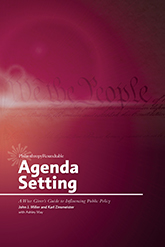
Donating money to modify public thinking and government policy has now taken its place next to service-centered giving as a constructive branch of philanthropy. Many donors now view public-policy reform as a necessary adjunct to their efforts to improve lives directly.
This is perhaps inevitable given the mushrooming presence of government in our lives. In 1930, just 12 percent of U.S. GDP was consumed by government; by 2012 that had tripled to 36 percent. Unless and until that expansion of the state reverses, it is unrealistic to expect the philanthropic sector to stop trying to have a say in public policies.
Sometimes it’s not enough to build a house of worship; one must create policies that make it possible for people to practice their faith freely within society. Sometimes it’s not enough to pay for a scholarship; one must change laws so that high-quality schools exist for scholarship recipients to take advantage of.
Yet public-policy philanthropy has special ways of mystifying and frustrating practitioners. It requires understanding of governmental practice, interpretation of human nature, and some philosophical perspective. Public-policy philanthropists may encounter opponents operating from different principles who view them as outright enemies. Moreover, public-policy struggles never seem to end: victories one year become defeats the next, followed by comebacks, then setbacks, and on and on.
This book was written to help donors navigate all of those obstacles. It draws on deep history and rich interviews with the very best practitioners of public-policy philanthropy in America today. Whatever your aspirations for U.S. society and governance, this guide will help you find the best ways to make a difference.
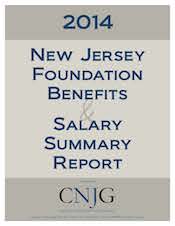
The 2014 New Jersey Foundation Benefits & Salary Report provides a valuable benchmarking resource, developed and compiled for exclusively for CNJG members. The first section, the 2014 Benefits Summary Report: New Jersey includes benefits data related to employment, leave, retirement, costs and more. The second section, the 2014 Grantmaking Salary Tables: New Jersey, Tri-State Area and National Data provides compensation across a wide range of positions and grantmaking entities, and includes salary data from the Council on Foundations’ 2014 Grantmakers Salary Survey.
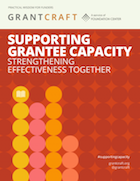
In Supporting Grantee Capacity: Strengthening Effectiveness Together, GrantCraft looks at how funders approach building capacity with grantees. Through examples from foundations ranging in size, mission, and geography, we explore various strategies for capacity building and the types of awareness that funders can choose to incorporate in decision making to facilitate informed, thoughtful judgments about strengthening organizations.
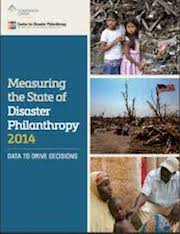
Measuring the State of Disaster Philanthropy 2014: Data to Drive Decisions is the most comprehensive analysis to date on disaster-focused philanthropy. Published by Foundation Center and the Center for Disaster Philanthropy, the report provides a snapshot of funding for disasters by the largest U.S. foundations. This analysis focuses on 2012 data to establish a baseline and is the beginning of a longer- term effort to collect and aggregate data—from multiple streams—in order to track disaster giving globally. As these data collection efforts move forward, subsequent reports will feature more current and comprehensive trends on disaster-related giving.
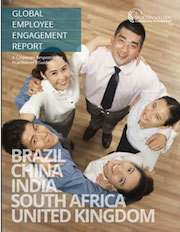
The Global Employee Engagement Report: A Corporate Responsibility Practitioner’s Guide is designed to provide practical information to companies looking to expand their employee engagement programs internationally. The report explores the employee engagement landscape in five countries: China, Brazil, India, South Africa and the United Kingdom. SVCF surveyed existing literature (global and country-specific) and conducted in-depth interviews with 65 corporate and nonprofit practitioners who have direct experience with employee engagement programs in the five countries studied. The report identifies cultural nuances, policies and trends that practitioners should be aware of as they design locally relevant programs.
Developed by the Southern Law Poverty Center, the guide (available in pdf and website formats) provides advice and suggestions for responding to everyday bigotry in a variety of settings-- among family, among friends and neighbors, at work, at school, and in public.
In the making of this book, the Southern Poverty Law Center gathered hundreds of stories of everyday bigotry from people across the United States. They told their stories through email, personal interviews and at roundtable discussions in four cities: Baltimore, Md.; Columbia, S.C.; Phoenix, Ariz.; and Vancouver, Wash. People spoke about encounters in stores and restaurants, on streets and in schools. They spoke about family, friends, classmates and co-workers. They told us what they did or didn’t say — and what they wished they did or didn’t say.
As a follow-up to our Giving in Indiana study (released earlier this year), Indiana Philanthropy Alliance is pleased to share this snapshot of promising practices for advancing diversity, equity and inclusion in Indiana philanthropy. Throughout our state, foundations are incorporating the values of diversity, equity and inclusion (DEI) into their organizational cultures; engaging diverse populations as staff, board members, donors, and grantees; and working to make their communities more welcoming places. This report is an effort to capture a sampling of these endeavors.
Community foundations are beginning to deepen and shift how they work, adopting an anchor mission that seeks to fully deploy all resources to build community wealth. Moving into territory relatively uncharted for community foundations, they are taking up impact investing and economic development — some in advanced ways, others with small steps. This report offers an overview of how 30 representative community foundations — including The Seattle Foundation, the Vermont Community Foundation, and the Greater Cincinnati Foundation — are working toward adopting this new anchor mission.
This Democracy Collaborative report was written by Marjorie Kelly, Senior Fellow and Director of Special Projects and Violeta Duncan, Community Development Associate.
Grantmaking at the Crossroads is a workbook designed to provide foundations with a new grantmaking methodology that works at the intersection of place, population, and issue. It offers a pathway to greater inclusion of communities that are often excluded or marginalized by foundation funding and enables foundations to maintain their focus and priorities while expanding their reach and effectiveness.
The Grand Rapids Community Foundation and the Kalamazoo Community Foundation volunteered to be laboratories for Grantmaking at the Crossroads and have been critical informants for this workbook. Each of these foundations holds an unwavering commitment to ongoing learning; this publication would not have happened without their support and engagement and the financial support of the Arcus Foundation.
In 2004, a group of foundations came together to create a funder collaborative in support of Freedom to Marry’s state-by-state strategy to win marriage equality. Over the following 11 years, this unique collaborative and its funding partners invested a total of $153 million to support a wide range of activities across the country to change hearts and minds on a massive scale — and ultimately to deliver a historic win for equality and love.
A new case study and video tell the untold, behind-the-scenes story of this funder collaborative — how its members worked with movement leaders to develop a strategy for winning, how they persevered in their support despite enormous setbacks, and how they invested in the opinion research, state-by-state grassroots action and litigation that pushed marriage over the finish line from coast to coast. As the Civil Marriage Collaborative closes its doors in 2015, the case study and video also draw lessons from this historic victory for foundations supporting other social justice causes.
From the Commonfund, these white papers on investment policy statements, spending policy, board governance and risk tolerance, together with their most recent studies of investments at private and community foundations, operating charities and nonprofit healthcare organizations are made available though CNJG's Investment Forum for Foundations and Endowments.
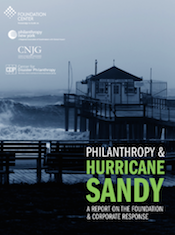
This new report from CNJG and partners examines the response of foundations, corporations, and other institutional donors to the devastation wrought by Hurricane Sandy in October 2012. Numbering nearly 600, these funders have so far committed more than $380 million for relief, recovery and building efforts. The hard data and reflective observations in the report contribute to the growing body of knowledge that helps foundations and corporations be strategic and effective with their giving when disaster strikes.
Two years after the historic storm, Philanthropy & Hurricane Sandy: A Report on the Foundation & Corporate Response breaks down the allocation of dollars contributed thus far and offers perspective on the role of private giving in disaster response and lessons to be taken from this one. The report was published by the Foundation Center in partnership with the Council of New Jersey Grantmakers and Philanthropy New York, and with support from the Center for Disaster Philanthropy.
“Throughout the past two years, our exceptional nonprofit and funder community has taken on challenges they never imagined,” said Nina Stack, president of the Council of New Jersey Grantmakers. “These organizations continue to develop innovative solutions that other communities will learn from and build upon in future disasters.”
In addition to the report’s numerous funders, CNJG wishes to thank the PSEG Foundation for supporting this project.
Foundations Facilitate Diversity, Equity, and Inclusion: Partnering with Community and Nonprofits, a new report by the OMG Center for Collaborative Learning, confirms that foundations can, in fact, facilitate diversity, equity, and inclusion (DEI) through their grantmaking processes and their partnerships with nonprofits—and identifies eight specific practices for foundations to emulate.
The report takes a deep dive into the work of nine foundations that represent a diverse cross-section of types and sizes, and offers useful lessons about how foundations can better partner with nonprofits to be more effective in their work.
A new nonpartisan resource, Foundation Funding for U.S. Democracy, provides data about foundations and their democracy-related grantmaking in a structured, contextualized, and visual format. Foundation Funding for U.S. Democracy was created through a partnership of eight funders in the field, including the Rita Allen Foundation, and is being developed by the Foundation Center.
The tool allows funders, nonprofits and other interested parties to sift through data on the $1.7 billion (and counting) granted by foundations to strengthen civic engagement in the United States since 2011. For the first time, we have an open tool for visualizing who gave how much to whom for what. While the tool and the data will continue to develop, it already gives a tremendously useful view of opportunities for greater partnerships and knowledge in the field—both for funders and for the organizations, small and large, established and emerging, working to strengthen our democracy. As Kelly Born of the Hewlett Foundation, another of the project partners, writes in a post introducing the tool: “As useful as this data set and visualization will be for foundations already working in the field or new funders considering entering it, the real killer app for this work will be to help grant seekers.”
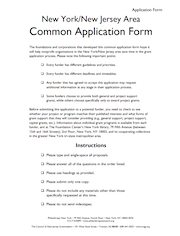
More than a decade ago, the Council of New Jersey Grantmakers and Philanthropy New York spearheaded a project to develop common application and report forms to help streamline the grant application process and ease the often time-consuming grant preparation process.
This application is a four-page form, which includes directions for use, a sample cover sheet, and the common grant proposal guidelines.
The separate Common Report Form follows closely the format of the New York/New Jersey Area Common Application Form.
Information for Grantmakers:
One of the core values at the Trust-Based Philanthropy Project (with whom CNJG partnered on a trust-based grantmaking learning series in the summer of 2021 – read about Part 1, Part 2, and Part 3) encourages funders to streamline their requirements for paperwork from nonprofits. Accepting the NY/NJ Area Common Grant Report Form is one way. Another is to accept reports from nonprofits that they submitted to a different funder.
Recent articles from Vu Le at NonprofitAF.com (We need to have a serious talk about character limits on grant applications and Trust-based grantmaking: What it is and why it’s critical to our sector), Joan Garry in the Chronicle of Philanthropy (A Plea from Community Nonprofits for Investment Equity and less Bureaucracy), and the research project by the Technology Association of Grantmakers (Grant Applications Share 39% Similarity According to New Research by TAG) in the summer of 2021 have re-focused attention on the concept of a common grant application.
CNJG encourages our members to review the application and report form, and consider accepting these forms (or using these questions on your online application / report form) from your current or potential grantees.
CNJG surveyed our members in August 2021 asking if they accepted the NY/NJ Area Common Grant Application and report form. CNJG members can download that report (link forthcoming).
Information for Grantseekers:
Before sending this (or any) application to any funder, be sure to check their specific funding guidelines and application requirements. Some funders require preliminary, additional, or supplementary information. Some funders only accept their own application form. CNJG members are under no obligation to accept either the common grant application or common grant report form.
Additional notes when using the NY/NJ Area Common Grant Application Form:
- Please check with each individual funder if they accept only their own form, the NY/NJ Area Common Grant Application form, or some other form.
- Funding area guidelines still apply. Research each organization’s funding areas to be sure your proposal fits within their guidelines before submitting your application.
- Any funder that has agreed to accept the NY/NJ Area Common Grant Application may request additional information at any stage in their application process.
- Every funder has different deadlines and timetables. Refer to each organization's funding and/or reporting guidelines.
- Do not submit the NY/NJ Area Common Grant Application or report form to the Council of New Jersey Grantmakers. Submit your application directly to the organization from which you are requesting support.
- Questions should be directed to the organization from which you are requesting support.
Low levels of diversity in the senior ranks of foundations have proven to be a stubborn challenge for the field of philanthropy. A newly-released report by Forward Change takes an important step toward a deeper understanding of the career pathways of professionals of color in philanthropy—how they enter foundations, how they advance across their careers, and what factors affect their advancement within the sector.
Nonprofits can and should play an active role during elections, particularly by educating and activating voters. However, with important local, state and federal elections coming up this fall, nonprofits should take the time to remind their staff about appropriate activity during a political campaign or at any other time. This overview developed by Donors Forum provides important tips and examples of activities that are permissible for nonprofits during an election cycle.
“A Time for Action: Mobilizing Philanthropic Support for Boys and Young Men of Color” lays out a vision and a bold plan of action to maximize the potential of philanthropy and the private sector to increase opportunity for boys and young men of color that benefits the entire country. While it focuses on systems, policies, and practices that profoundly shape the lives of our sons and brothers, the recommended actions also help to create the conditions for all children and young adults to thrive, regardless of race, ethnicity or gender. The plan is bolstered by $194 million in initial investments in key initiatives, including for example programs to enhance school learning environments and reduce the overrepresentation of young people in the justice system.
